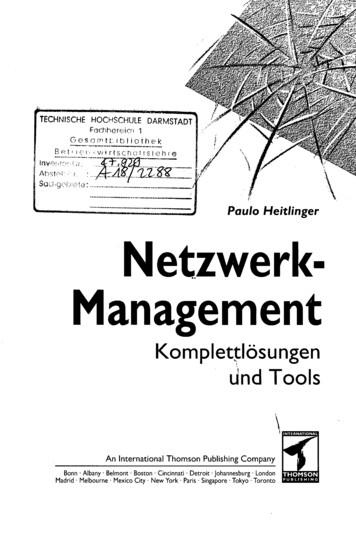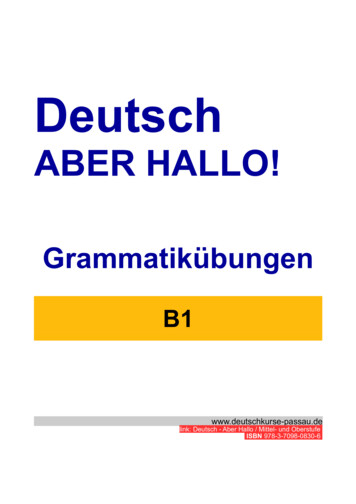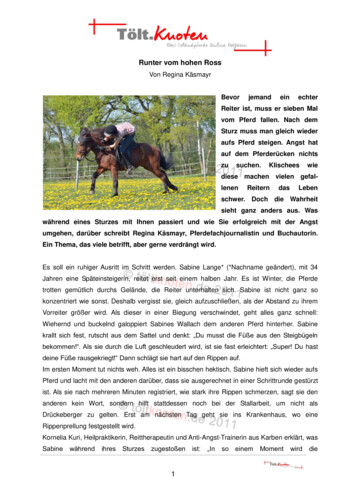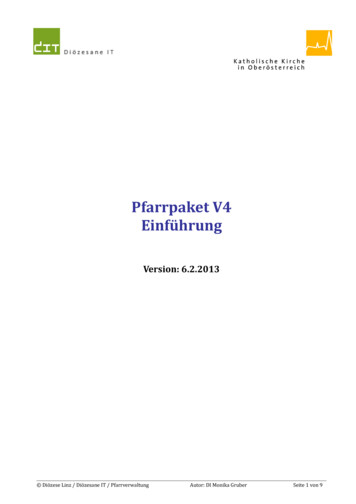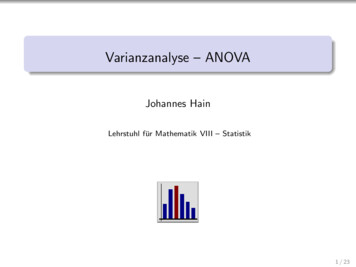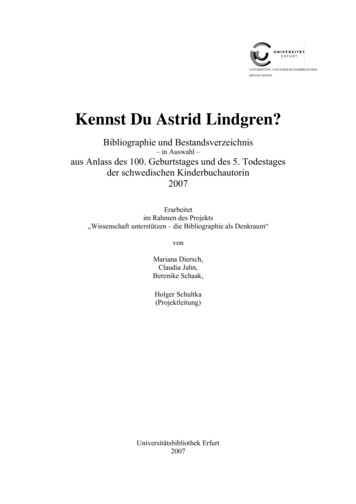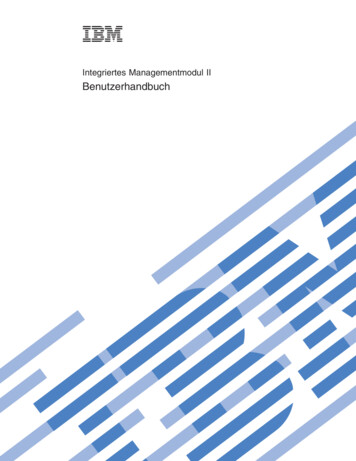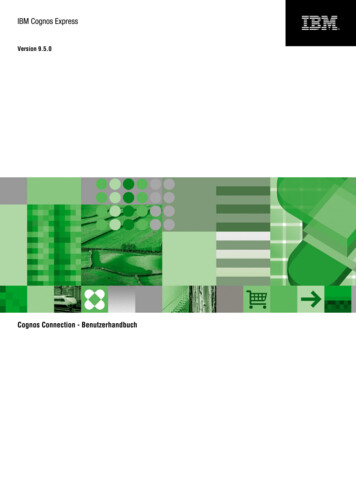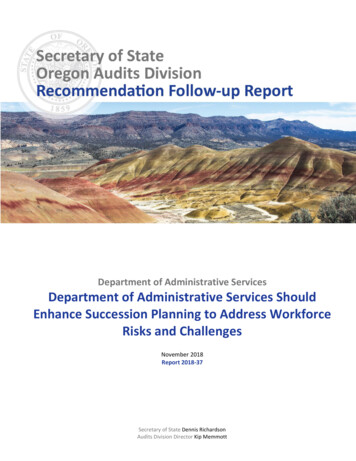
Transcription
Department of Administrative ServicesDepartment of Administrative Services ShouldEnhance Succession Planning to Address WorkforceRisks and ChallengesNovember 2018Report 2018-37Secretary of State Dennis RichardsonAudits Division Director Kip Memmott
This page intentionally left blank
November 2018Department of Administrative ServicesDepartment of Administrative Services Should Enhance Succession Planning toAddress Workforce Risks and ChallengesRecommendation Follow-Up ResultsThe Department of Administrative Services (DAS) agreed with the original audit, which identified eightrecommendations for implementing a succession planning framework. Our follow-up work shows DAS has fullyimplemented six of those recommendations since the initial report. This significant progress still requires alittle more work to implement the remaining two recommendations.Highlights from the Original AuditThe Secretary of State’s Audits Division found that DAS should play a stronger leadership role in addressing keyworkforce risks and challenges within the state executive branch through enhanced workforce successionplanning. Multiple factors indicate these risks and challenges are important including changing workforcedemographics, and citizens’ needs for essential services that require skilled and experienced staff.BackgroundOur original audit reviewed succession planning within Oregon’s executive branch. Succession planning is anongoing management process used to ensure workforce continuity and effectiveness, particularly in keyleadership and technical functions.PurposeThe purpose of the audit was to determine if and how the State of Oregon could better plan for future keyworkforce needs, including preparing state employees to fill key roles. The purpose of this follow-up report isto provide a status on the auditee’s efforts to implement our recommendations.Key FindingsWithin the context that effective succession planning is difficult, complex, and is frequently not a priority withinthe public sector, we found:1. DAS has not developed or implemented a state-level succession planning framework, despiterecognizing the importance of succession planning.2. The lack of a succession planning framework increases workforce risks, such as not developingor retaining knowledgeable and skilled employees to perform critical functions.3. These risks are exacerbated by demographic and economic trends, including increasingretirement rates, and a lack of formal succession planning processes within state agencies.4. State agencies also report challenges, including inaccessible workforce information that mayhinder strategic human capital management practices and should be addressed at a state level.
IntroductionThe purpose of this report is to follow up on the recommendations we made to the Departmentof Administrative Services in audit report 2017-21, “Department of Administrative ServicesShould Enhance Succession Planning to Address Workforce Risks and Challenges.”The Oregon Audits Division conducts follow-up procedures for each of our performance audits.This process helps assess the impact of our audit work, promotes accountability andtransparency within state government, and ensures audit recommendations are implementedand related risks mitigated to the greatest extent possible.We use a standard set of procedures for these engagements that includes gathering evidence andassessing the efforts of the auditee to implement our recommendations; concluding andreporting on those efforts; and employing a rigorous quality assurance process to ensure ourconclusions are accurate. Implementation status determinations are based on an assessment ofevidence rather than self-reported information.To ensure the timeliness of this effort, the division asks all auditees to provide a timeframe forimplementing the recommendations in our audit reports. We use this timeframe to schedule andexecute our follow-up procedures.Our follow-up procedures evaluate the status of each recommendation and assign it one of thefollowing categories: Implemented/Resolved: The auditee has fully implemented the recommendation orotherwise taken the appropriate action to resolve the issue identified by the audit.Partially implemented: The auditee has begun taking action on the recommendation,but has not fully implemented it. In some cases, this simply means the auditee needsmore time to fully implement the recommendation. However, it may also mean theauditee believes it has taken sufficient action to address the issue and does not plan topursue further action on that recommendation.Not implemented: The auditee has taken no action on the recommendation. This couldmean the auditee still plans to implement the recommendation and simply has not yettaken action; it could also mean the auditee has declined to take the action identified bythe recommendation and may pursue other action, or the auditee disagreed with theinitial recommendation.The status of each recommendation and full results of our follow-up work are detailed in thefollowing pages.Oregon Secretary of State Report Number 2018-37 November 2018 Page 1
Recommendation Implementation StatusRecommendationAuditee Action1. Develop a statewideworkforce succession planningstrategy and framework, inconsultation with state agenciesand stakeholders, that providesconsistent guidance anddirection, but also allowsagencies flexibility to managewithin their unique situations.DAS has developed a web page on itswebsite that is devoted to successionplanning. The webpage contains manyresources, including definitions, answers tofrequently asked questions, and asuccession planning guide. DAS alsoincludes a point of contact for questionsand assistance.Implemented/ResolvedDAS has developed a glossary of successionplanning terms and included this glossaryon its website.Implemented/Resolvedb) explanation of the keysuccession planning processesthat should be used;DAS’s succession planning webpageprovides several planning resources. Theseinclude an initial agency assessment tool, acritical position chart and tool, and asuccession planning guide.Implemented/Resolvedc) tools and templates to informsuccession planning such as toolsto identify and analyze skills gapsor identify talent pools;The succession planning page on DAS’swebsite contains tools and templates,including a succession planning guide,several communication planning tools, andposition planning tools.Implemented/Resolved2. Provide specific guidance tostate agencies on successionplanning, similar to the toolkitsprovided by other states,including but not limited to:a) definitions of concepts forstatewide use, such as definingworkforce planning, successionplanning and retirementeligibility;StatusOregon Secretary of State Report Number 2018-37 November 2018 Page 2
DAS has completed some work in this area,but at present, there are no metrics thatwould allow DAS or agencies to determineif succession planning efforts are adequateat either the agency or statewide level.d) recommended metrics tomeasure performance; ande) recommended approaches tomeet public sector principlessuch as guidance on developing acommunication plan forimproved transparency.DAS’s succession planning guide brieflytouches on performance measurement,highlighting a limited number of possiblemeasures. DAS also reports that its staff arebeginning to gather data, and some old HRsystems contain metrics. DAS is hoping thatWorkday, its new statewide HR informationsystem, will provide better data analyticstools.PartiallyimplementedEquity, merit, and fairness are componentsof DAS’s succession planning guide, andtransparency is identified in a description ofvalues adopted by the Oregon EnterpriseLeadership Team (ELT). This team includesmore than 20 state agency directors.The values and competencies adopted bythe ELT support succession planningprinciples. The values includeaccountability, integrity, equity, andexcellence.Implemented/ResolvedDAS has also produced a set ofcommunication tools to support successionplanning. These tools include acommunication strategy guide.3. Develop and implementprocesses to monitor, assess andaddress state agency efforts andstate workforce risks to ensurecritical positons are filled withqualified staff. This shouldinclude:a) regularly collectinginformation from state agenciesabout their actions and risks;DAS has developed an annual survey it willsend to state agencies. This survey collectsinformation that allows DAS to monitor andassess agency efforts and state risks.DAS has also provided three employeesurvey tools for the agencies to use. Thesetools will provide agencies information ondata needs and possible risks.Implemented/ResolvedDAS is also collecting agency levelinformation as it provides technicalassistance to the agencies.Oregon Secretary of State Report Number 2018-37 November 2018 Page 3
b) assessing workforce risks,such as retirement eligibility,from a state-level perspective;andc) Regularly communicating (e.g.,by publishing online) workforceinformation to state agenciesand stakeholders, such as theLegislature, public and labororganizations.DAS’s outreach efforts, annual agencysurvey tools, and the retirement eligibilitydata discussed in recommendation no. 6,will assist DAS and agencies in assessingretirement eligibility risks.DAS has developed tools to communicatewith agencies via its website, outreachactivities, technical assistance efforts, andregular meetings with HR managers andagency directors.DAS is also communicating withstakeholders through its website andbelieves Workday will allow them toprovide additional workforce data when d4. Work with agencies to defineessential data needs related tosuccession planning and ensureneeds are met, includingworkforce demographics andretirement eligibility data.DAS sought agency input regarding dataneeds when it developed the Workdaybusiness case. DAS plans to include thesedata elements in Workday.Implemented/Resolved5. Work with PERS to obtainretirement eligibility data inorder to improve the accuracy ofworkforce information used forbroad succession planningstrategies. Address any concernsabout individual privacy andguard against any potential forage discrimination.DAS has entered into an intergovernmentalagreement with PERS to obtain limitedretirement eligibility data on a regularbasis. This data will be uploaded toWorkday. Note: Physical access will notoccur until DAS launches Workday.Implemented/Resolved6. Provide guidance and trainingin the new human resourceinformation system to state HRemployees to ensureappropriate business processchanges are made to supportand capitalize on the newsystem, and to ensure dataintegrity.Though Workday does not have a firmlaunch date, DAS has begun developingtraining materials and placing them on theWorkday webpage.PartiallyimplementedOregon Secretary of State Report Number 2018-37 November 2018 Page 4
DAS is taking steps to foster cooperationand coordination through its successionplanning efforts.Specific actions include:7. Expand on currentopportunities for state agenciesto share practices andcoordinate with each other andDAS. This should includeincreasing outreach to agenciesnot represented at the HRadvisors meeting, expandingopportunities at the HR directorsmeeting for agency collaborationand sharing, and reaching out toHR directors who do notregularly attend the HR directorsmeeting.1. Identifying and encouragingcoordination and sharing as animportant tool.2. Providing support, training, andassistance to agencies seeking tocoordinate and share information.3. Encouraging agencies to work togetherwhen an opportunity for collaborationexists. DAS does this through its regularHR director's meetings, statewidecommunication outreach efforts, and inits daily communications with agenciesincluding through existing tools, such asthe statewide HR newsletter.Implemented/Resolved4. Hosting open events to all HR staff notrepresented at the either of thedirector level meetings.8. Work with state agencyexecutives and HR personnel toaddress barriers in successionplanning related to state HRpolicy, rules, or processes, bymaking adjustments whenappropriate and providingguidance to agencies on how toachieve objectives withinexisting state structures.DAS has taken steps to engage stateexecutives in an effort to build awareness,and develop a statewide capacity toaddress barriers, including:1. Presenting the succession planningproject to the ELT.2. Modifying its policy review process toinclude a review by ELT members andagency directors who are not ELTmembers.Implemented/Resolved3. Actively communicating with agenciesthrough their outreach efforts noted inprevious recommendations.Oregon Secretary of State Report Number 2018-37 November 2018 Page 5
ConclusionDAS has made significant progress to implement the recommendations of the report. The agencydeveloped a strategy and framework to manage succession planning. In addition, DAS developedthe guidance and tools needed to get agencies started in their implementation of the successionplanning framework. They have also communicated regularly with agencies and are providingsupport as requested.This significant progress still needs a little more work to mitigate the unique risks identified inour original report. There are eight recommendations, two of which have multiple parts. Asindicated in the status summary, we conclude DAS has completed sufficient work on six of theeight recommendations. One of the remaining two items, recommendation no. 2d, is aboutdeveloping metrics to measure the performance of succession planning efforts. DAS has begunwork on this, but has not yet created, or recommended, any metrics.In DAS’s response to the original audit, recommendation no. 6 was to be completed with thelaunch of Workday, a new statewide HR system. DAS has pushed the launch of Workday backmany times, and has not yet set a firm launch date.We sincerely appreciate the courtesies and cooperation extended by officials and employees ofDAS during the course of this follow-up work.Oregon Secretary of State Report Number 2018-37 November 2018 Page 6
Follow-up Report TeamWill Garber, CGFM, MPA, Deputy DirectorAndrew Love, Audit ManagerKyle Rossi, Senior AuditorRod Campbell, Staff AuditorAbout the Secretary of State Audits DivisionThe Oregon Constitution provides that the Secretary of State shall be, by virtue of his office, Auditor of PublicAccounts. The Audits Division performs this duty. The division reports to the elected Secretary of State and isindependent of other agencies within the Executive, Legislative, and Judicial branches of Oregon government.The division has constitutional authority to audit all state officers, agencies, boards and commissions as well asadminister municipal audit law.This report is intended to promote the best possible management of public resources.Copies may be obtained from:Oregon Audits Division255 Capitol St NE, Suite 500 Salem OR 97310(503) 986-2255sos.oregon.gov/audits
1. DAS has not developed or implemented a state- level succession planning framework, despite recognizing the importance of succession planning. 2. The lack of a succession planning framework increases workforce risks, such as not developing or retaining knowledgeable and skilled employees to perform critical functions. 3.
